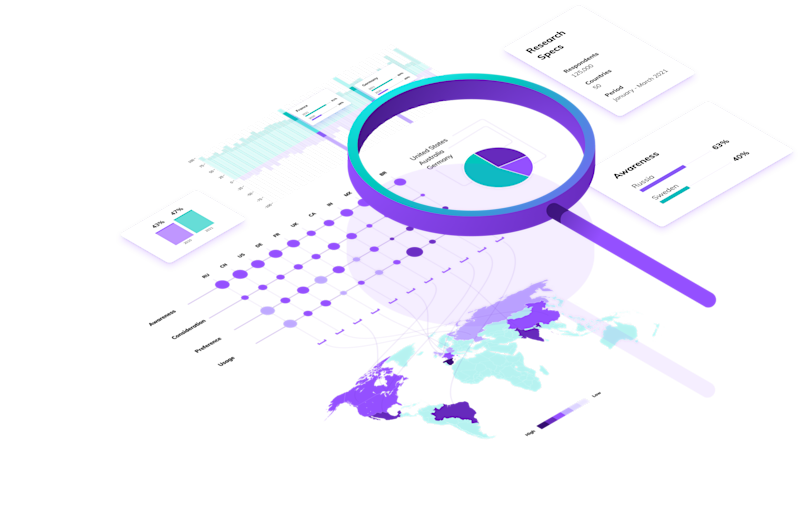Don’t worry, you aren’t the only person who’s heard phrases like “API-powered sampling” or “ad-tech infrastructure” and felt a bit confused. There was a time when these were new concepts to us, as well.
But fear not — we’ll break it all down in this article, and you’ll walk away with a working knowledge of both topics, as well as why they’re both beneficial when using brand tracking software.
So, without further ado, let’s get started.
What is API-Powered Sampling?
Let’s start with the basics — what does API mean? API actually stands for “application programming interface”, which basically refers to the connection between computers or between computer programs.
In simpler terms, API is a software go-between that allows two applications to talk to one another. In our case, it allows our data pipeline to communicate with exchanges and partners providing access to survey respondents.
To be fair, “API-powered sampling” is a term that we at Latana made up. A more commonly-used version would be programmatic sampling. API-powered sampling — like programmatic sampling — is, in essence, a form of optimized sampling.
At Latana, API-powered sampling refers to the exchanges that happen automatically between our system and the different sample providers that we work with, such as traditional panels or ad space managers.
Thus, we work with both incentivized and non-incentivized sampling as a means of data collection. Let’s break down each option.
What Is Incentivized Sampling?
Incentivized sampling, aka surveys with a reward-based system, requires us to work with traditional panels and invitational APIs.
These function via opt-in respondents who are rewarded for taking our surveys — which is why it’s referred to as “incentivized” sampling.
Many brands that run surveys to capture consumer insights use incentivized sampling because it allows for longer surveys, deeper profiling, and a wider range of question formats.
However, incentivized surveys can also run into issues — usually surrounding data quality and fraud. For this reason, some companies choose to work with non-incentivized sampling.
What is Non-Incentivized Sampling?
Comparatively, non-incentivized sampling is a form of gathering consumer survey data where respondents are not rewarded for their participation. However, as this option uses an open ad network to find participants, it allows for a wider reach and more granular targeting.
Additionally, non-incentivized sampling allows for improved privacy measures and increased data accuracy. However, non-incentivized sampling does have a limit to survey length, which means longer surveys won’t be viable. To tackle this issue we modularize our surveys and use advanced data processing techniques to stitch datasets back together.
At Latana, we use an API approach for both incentivized and non-incentivized sampling.
For non-incentivized sampling, we work with a demand-side platform (essentially a go-between) — that makes it possible for our adverts to be seen by respondents. In this case, the API portion of the setup works as a means to optimize and automate bidding for ad spaces.
When it comes to optimized, automated bidding, a great deal depends on how competitive the market is and how much a buyer is willing to pay. For example, sometimes non-incentivized surveys receive far more Android users than iPhone users. Why? Because it’s more expensive to get an advert into an iPhone space than an Android one.
On the other hand, Android has a lot more (albeit low-quality) apps, meaning it’s easier to reach Android users with optimized ads than it is to reach iPhone users. Therefore, to ensure an even sampling of both groups, buyers sometimes have to pay more for iPhone ad space.
Ultimately, API-powered refers to the algorithm that works in the background to ensure we win ad space and are able to reach respondents. This setup allows us to ensure we have a continuous flow of high-quality data. For incentivized sampling, API is used to manage sampling sources. And for non-incentivized sampling, the API aspect is used for optimizing bidding to earn ad space.
At Latana, we use API-powered sampling to connect with real-time online respondents to generate authentic opinions and avoid the learned respondent behavior of traditional panels. Thus, we are able to provide more accurate, representative data.
What is Ad-Tech Infrastructure?
First, let’s start with “ad-tech”. According to Gartner, ad-tech is “a set of technologies used for managing advertisements across channels, including search, display, video, mobile and social, with functions for targeting, design, bid management, analytics, optimization and automation of digital advertising.”
The “infrastructure” part is a bit easier to understand, as it refers more loosely to the set of systems that operate and manage our ad-tech requirements.
For Latana, we use ad-tech infrastructure to publish both incentivized and non-incentivized surveys. Thus, it functions as an opt-in infrastructure.
For example, instead of actively emailing respondents to gather survey data, we partner with apps and websites that published our surveys for potential respondents to choose to participate in. This means that respondents are mostly new to our surveys, and, therefore, we do not have a high level of repeat participants. This approach allows us to ensure we have a fresh sample, which provides more accurate data.
Essentially, ad-tech infrastructure makes it possible for us to publicly display our surveys on partner apps and websites in an opt-in format that respects consumer privacy and provides more reliable data.
How Can Both Techniques Benefit Your Brand?
There are many ways that both API-powered sampling and ad-tech infrastructure can benefit your company when it comes to gathering brand tracking data.
According to an article for GreenBook by JD Deitch, the COO of Cint:
“One of the central benefits of programmatic sampling, as the name would imply, is the replacement of manual processes by computer programming. With machines doing the routine work of data retrieval and transmission, companies benefit from lower costs, greater efficiency, and reduced error rates.”
Thus, API-powered sampling automates a great deal of work that was previously done manually — leading to more efficient processes overall.
Another main benefit of using API-powered sampling? It’s less error-prone, because:
“a computer program that is properly ‘specific’ and targeted is going to make fewer mistakes. In fact, it will actually expose weaknesses elsewhere in the process that are human-driven or less precise, e.g., errors in quota specifications or questionnaire programming.”
Additionally, we’re able to generate more samples by using automated processes — which is far easier and more efficient than manually emailing participants.
Clearly, API-powered sampling boasts a host of benefits when used to gather brand tracking data. By making certain that each survey has fresh, new respondents, we at Latana can ensure that our brand perception data is realistic.
Final Thoughts
We hope you now possess a better understanding of both API-powered sampling and ad-tech infrastructure and agree that — once explained — they’re not so confusing after all.
If you’d like to learn more about Latana’s processes, such as the use of Multi-Level Regression & Poststratification (MRP) or why we use mobile-optimized surveys, you can check out our whitepapers.





